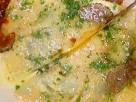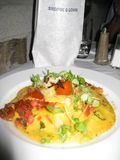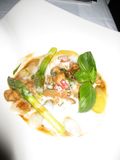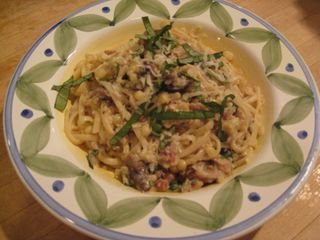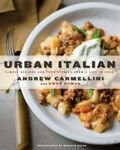Jan Norris, a 26-year veteran of the Palm Beach Post and one of the most knowledgeable and entertaining food editors I worked with during my years as Union-Tribune food editor, recently asked me about my favorite summer food memories. I wrote this 'ode to a plum tart' for her. It's included, along with the recollections of many other food writers, in a series about summery foods on her blog.
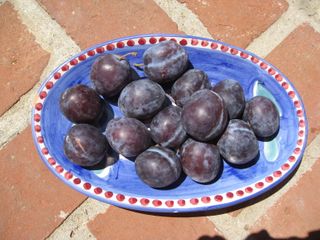 Pflaumenkuchen. I was flummoxed by the very sound of the word. Yet the syllables tripped off the tongue of the woman patting out the pie crust as easily as shiny little pebbles slipping downstream.
Pflaumenkuchen. I was flummoxed by the very sound of the word. Yet the syllables tripped off the tongue of the woman patting out the pie crust as easily as shiny little pebbles slipping downstream.
I had been dating a charming “Virginia Gentleman,” called “T” by his friends, for less than a month when he invited me to visit his parents’ home one late-August weekend. Little did I know that I’d marry him 11 months later. Little did I know that I’d get a fabulous Pflaumenkuchen recipe in the deal.
Pflaumen (pronounced flow (as in flower)- men) is the German word for prune plums. (Kuchen is cake, though this creation is more of a tart.) Also known as Italian Prune Plums, these precious nuggets are available for a very brief period -- two or three weeks max each summer, in late August and early September. They’re the size of a baby’s fist, slightly egg-shaped, with blue-purple skin, freestone pits (which separate easily) and yellowish flesh. Though they’re tasty eaten out of hand, prune plums are best cooked or baked, when they become soft, jammy and fragrant, with nicely caramelized edges.
But, back to Carola Shiftan, who was born in a tiny village in East Germany and arrived in the United States towards the end of WWII, a few years before her son Thomas was born. She was an elegant woman with a warm, welcoming personality and an exotic (to me) accent. She liked to cook and bake, and had an impressive cookbook collection.
 As a 20-year-old born-and-bred Bostonian, I knew little about European cuisines and even less about the guttural German language. But I watched and listened, fascinated, as she mixed a few ingredients in a bowl, lined a pie plate with the dough, and laid little purple plum slices neatly and tightly, side by side, like a Rockettes chorus line.
As a 20-year-old born-and-bred Bostonian, I knew little about European cuisines and even less about the guttural German language. But I watched and listened, fascinated, as she mixed a few ingredients in a bowl, lined a pie plate with the dough, and laid little purple plum slices neatly and tightly, side by side, like a Rockettes chorus line.
When she died, just four months after our July 1969 wedding, I was given her well-worn “Mastering the Art of French Cooking, Volumes I and II.” They were my introduction to the wonderful world of Julia.
But more importantly, on a faded piece of yellow legal paper folded up inside one of those books, I got the recipe for Pflaumenkuchen.
During the 40 years since then, my husband and I have awaited the end of August like little kids await Santa. I try to make the simple little tart several times during the “season,” and I just about cry the day I visit the market and find that they’re gone.
The Mürbeteig (loosely translated as “sweet dough”) is what the French would call pate brisee, but with a lot more sugar and butter. In fact, there’s so much butter involved that I have to use the little silver pie weights when I blind bake the shell.
After that, all that’s left to do is slice the plums, arrange them in concentric circles, sprinkle them with a bit of sugar and breadcrumbs (Progresso Plain is fine) and dot with a few more bits of butter.
Pflaumenkuchen is the epitome of summer food, the very essence of “eating seasonally.” And in our house, it brings a dearly-missed loved one back to the table every time we make it.
Here’s my mother-in-law’s recipe. I’m pretty casual about amounts of ingredients. Experiment and use what works best for you.
PFLAUMENKUCHEN
1 cup flour
1/3 cup sugar plus 2 teaspoons
Pinch salt
1 stick butter, cold, cut into small pieces
1 egg yolk
2-3 tablespoons ice water, as needed
About 16 Italian prune plums
2 teaspoons plain breadcrumbs
Place flour, sugar, salt and butter pieces into a food processor, reserving 4 or 5 little pieces of butter for later. Process in short bursts until mixture starts to have the texture of oatmeal. Add egg yolk and continue to process in short bursts until dough starts to come together in a ball. Add ice water, as necessary, to facilitate this.
Remove from food processor. Form gently into a ball, Dust with flour. Wrap in waxed paper or plastic wrap and refrigerate for an hour or so.
Roll out dough when it’s firm, patting it into a 10-inch fluted tart pan with removable bottom. Blind bake the pastry shell, filling with pie weights.
In the meantime, wash, pit and cut each Italian prune plum into 6 or 8 pieces. Arrange them in pie tart in concentric circles. (If you run out, you can make a row of sliced peach, nectarine or another type of plum.) Sprinkle with breadcrumbs and extra sugar. Dot with leftover butter bits. Bake in 350-degree oven for about 15 minutes, until plums are soft and jammy.


